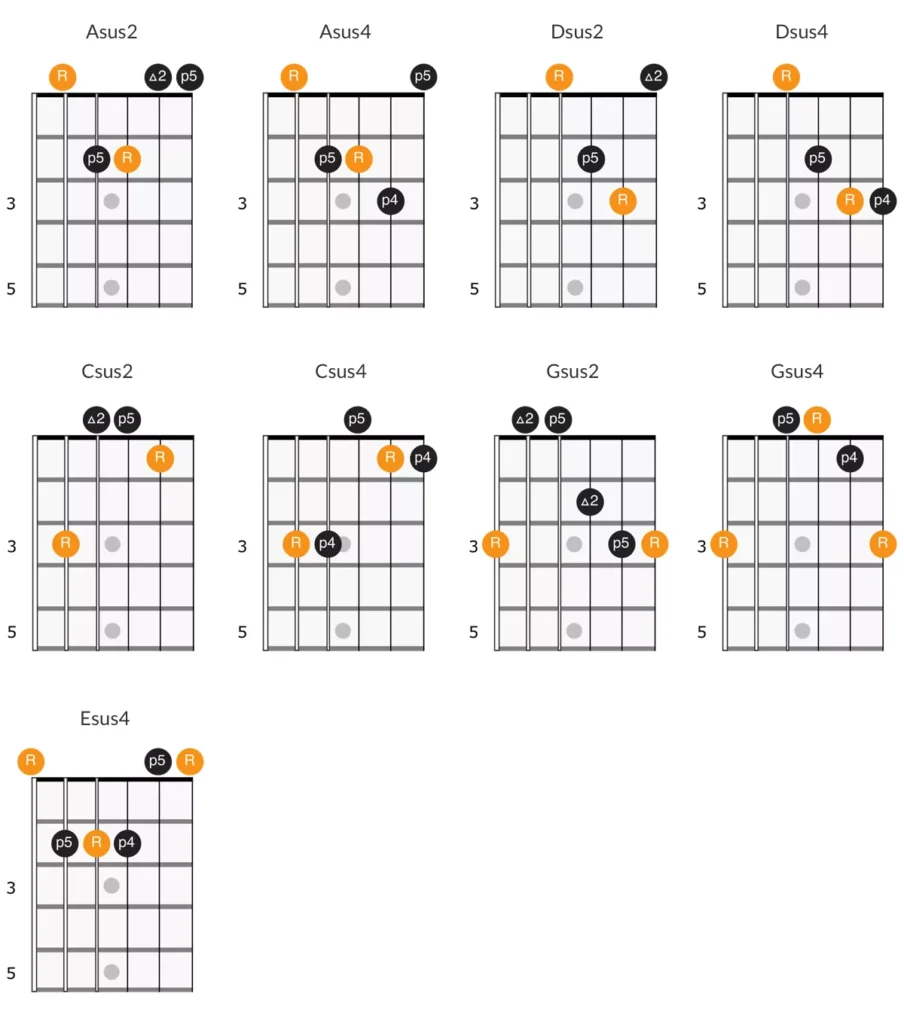Mastering chord variations is a crucial step in advancing your guitar skills and expanding your musical repertoire. In this blog post, we’ll delve into the world of A sus 2 chords and explore six different ways to play them on the guitar fretboard. By learning these variations, you’ll gain greater versatility and creative options when playing popular songs.

Understanding A Sus 2 Chords:
Before we dive into the chord shapes, let’s have a quick review of the theory behind A sus 2 chords. The “sus 2” in the name refers to the suspended 2nd degree of the chord, which replaces the 3rd. A regular A major chord consists of the notes A, C#, and E, whereas the A sus 2 chord replaces the C# with the 2nd degree, which is B. Therefore, the notes in an A sus 2 chord are A, B, and E.
Reading Chord Charts:
Before we explore the chord variations, it’s essential to know how to read chord charts. The horizontal lines represent the strings, with the top line being the high E string and the bottom line being the low E string. The vertical lines separate the frets, and the numbers in blue dots indicate which fingers to use on the fretting hand. Letters on the right of the charts represent the notes played on each string, while circles denote open strings, and a red X means to avoid that string.
A Sus 2 Chord – Open Shape:
The easiest way to play the A sus 2 chord is with the open chord shape. This form involves only two fretted notes on the 3rd and 4th strings. You can either use fingers 1 and 2 or fingers 2 and 3, depending on what feels more comfortable for you.
A Sus 2 Chord Variation 1:
Moving to the middle area of the fretboard, we find another open chord variation of the A sus 2 chord. Similar to the previous shape, you’ll only need to fret the 3rd and 4th strings, making it relatively simple to play.
A Sus 2 Chord Variation 2:
This variation incorporates open strings and requires a wider stretch between your 1st and 4th fingers. Although it’s more challenging, practicing this shape will enhance your finger dexterity and reach on the fretboard.
A Sus 2 Chord Mini Barre:
For this variation, we introduce a mini barre starting on the 4th string, 7th fret. Utilizing a barre chord technique gives this shape a slightly different tonal quality, adding versatility to your chord voicings.
A Sus 2 Chord on the 6th String:
This chord shape might be trickier to play due to the wider finger stretch required, but it brings a unique cluster sound to your playing. It’s well-suited for rock-style music and offers fresh ways to express yourself on the guitar.
A Sus 2 Chord on the 5th String:
Finally, we explore a less common variation of the A sus 2 chord, which offers a distinctive cluster sound created by the notes on the 5th and 4th strings. This unique sound can add depth and character to your chord progressions.
In Conclusion:
Learning these six ways to play an A sus 2 chord on the guitar opens up a world of possibilities for your musical journey. By understanding the theory behind the chord and mastering these different variations, you gain the flexibility to move freely around the fretboard and can better support melodic lines when playing over songs.
Whether you’re strumming along to your favorite tunes or creating your own melodies, the A sus 2 chord variations offer exciting opportunities to elevate your playing. Experiment with these shapes and consider shifting them to different strings to unlock even more sus 2 chords in your repertoire. So grab your guitar and start exploring the rich sounds of A sus 2 chords in various musical contexts! Happy playing!